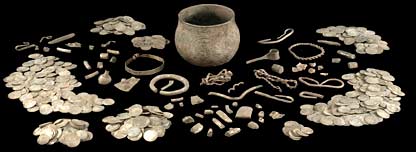This major Viking hoard, an important and exciting find, is joint-owned and will be displayed equally between the two partners. Highlights of the hoard will be displayed initially at the Yorkshire Museum in York (17 September – 1 November 2009). It will then travel to the British Museum.

Jonathan Williams, Keeper of Prehistory and Europe at the British Museum, said: “This find is of global importance, as well as having huge significance for the history of England and Yorkshire. York Museum Trust and the British Museum have worked together to acquire, interpret and exhibit the hoard to make it accessible to the widest possible public. We are hugely grateful to all funders whose generosity has meant we were able to acquire the hoard”.
The hoard was declared Treasure and was valued at £1,082,000 by the independent Treasure Valuation Committee. The Vale of York hoard has been acquired with the substantial and generous support of a National Heritage Memorial Fund (NHMF) grant of £507,100, and a £250,000 grant from independent charity The Art Fund. Additional funding came from the Challenge Fund (£97,500) and York Museums Trust (£30,000). A huge sum of £200,000 was raised through public appeal with many individual generous donations from the British Museum Friends. Additional funds were raised to cover conservation costs.
Andrew Macdonald, Acting Director of The Art Fund, said: “A treasure hunter’s dream, the Vale of York hoard is an extraordinary collection of artefacts that gives new insight into the vast trading networks – from Islamic Central Asia to Scandinavia and the Baltic – of 10th century Britain. The Art Fund is delighted to have helped York Museums Trust and the British Museum acquire this rare and exciting find.”
The size and quality of the material in the hoard is remarkable, making it the most important find of its type in Britain for over 150 years. It was discovered in the Harrogate area in January 2007 by two metal-detectorists, David and Andrew Whelan, who kept the find intact and promptly reported it to their local Finds Liaison Officer.
David and Andrew Whelan, the finders of the hoard, said “Being keen metal detectorists we always dreamt of finding a hoard, but to find one from such a fantastic period of history, is just unbelievable. The contents of the hoard we found went far beyond our wildest dreams and hopefully people will love seeing the objects on display in York and London for many, many years to come”.
The hoard contains a mixture of different precious metal objects, including coins, complete ornaments, ingots (bars) and chopped-up fragments known as hack-silver (67 objects in total and 617 coins). It shows the diversity of cultural contacts in the medieval world, with objects coming from as far apart as Afghanistan in the East and Ireland in the West, as well as Russia, Scandinavia and continental Europe.
The most spectacular single object is a gilt silver vessel, made in what is now France or western Germany around the middle of the ninth century. It was apparently intended for use in church services, and was probably either looted from a monastery by Vikings, or given to them in tribute. Most of the smaller objects were hidden inside this vessel, which was itself protected by some form of lead container. As a result, the hoard was extremely well-preserved. Other star objects include a rare gold arm-ring, and 617 coins, including several new or rare types. These provide valuable new information about the history of England in the early tenth century, as well as Yorkshire’s wider cultural contacts in the period. Interestingly, the hoard contains coins relating to Islam and to the pre-Christian religion of the Vikings, as well as to Christianity.
The hoard was probably buried for safety by a wealthy Viking leader during the unrest that followed the conquest of the Viking kingdom of Northumbria in AD 927 by the Anglo-Saxon king Athelstan (924-39).
Dr Robert Bewley, Director of Operations at the National Heritage Memorial Fund, said: “This archaeological find provides us with a unique and wonderful snapshot of troubled times in Britain and Europe, over a thousand years ago. We’re particularly pleased to see that our funding is helping to facilitate important joint working between the British Museum and York Museums Trust. This should ensure that these treasures can be enjoyed, in a variety of locations, by visitors from both this country and further afield.”
Conservation work has recently started on the hoard to restore it to its former glory. More information on the hoard has come to light through this process. The vessel which contained most of the hoard can now be seen to be decorated with niello (a black metal inlay), as well as extensive gilding. New details are also visible in the decoration of some of the silver jewellery fragments, and in the designs and inscriptions of the coins. The first newly conserved objects will be revealed on 27 August.
The Vale of York hoard is the largest and most important Viking hoard from Britain since the hoard found at Cuerdale in Lancashire in 1840. Objects from the Cuerdale hoard are now on display in several museums around the UK, with the largest group housed in the British Museum.
A Viking army conquered the Anglo-Saxon kingdom of Northumbria in AD 869. The area remained under Viking control until it was conquered by Athelstan in 927. The area had another brief period of independence following Athelstan’s death in 939, which lasted until the death of the Viking ruler Eric Bloodaxe in 954. The Vikings made a lasting impact in Britain, including place-names, sculpture and influence on the English language, as well as archaeological remains. Yorkshire is one of the areas which shows the strongest Viking influence.